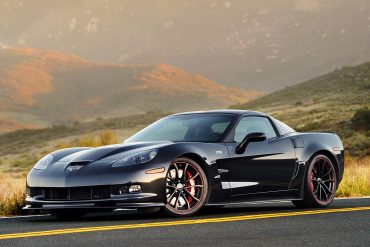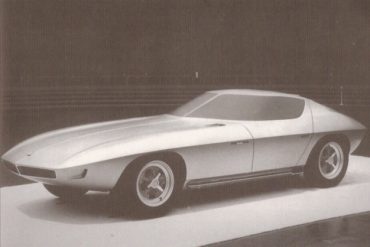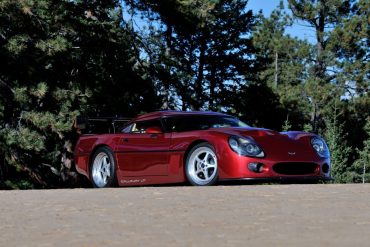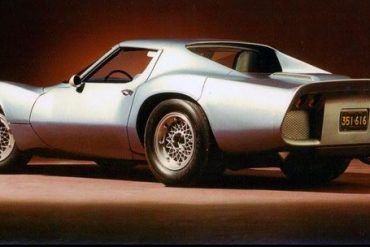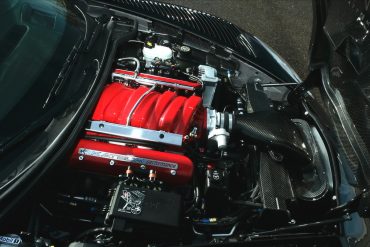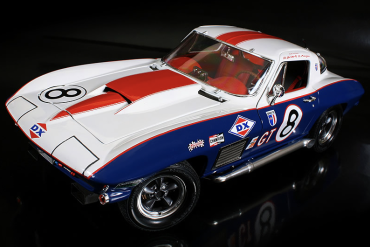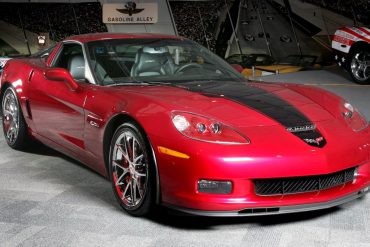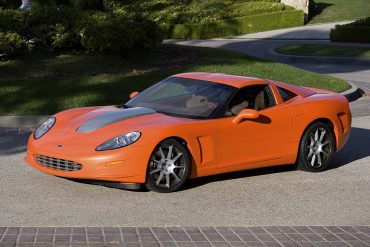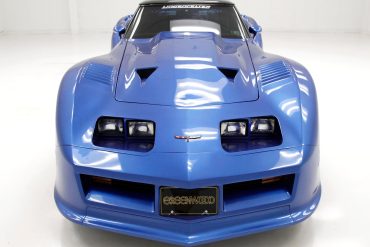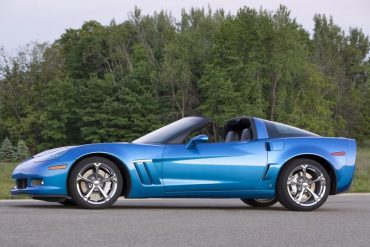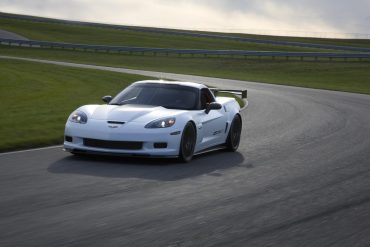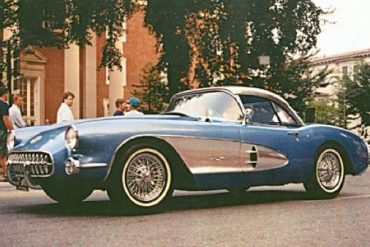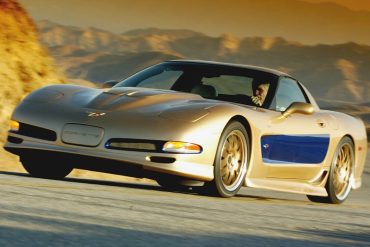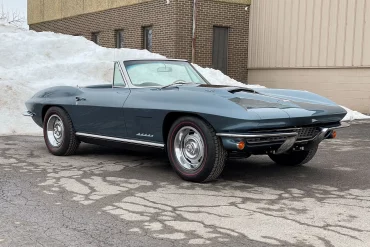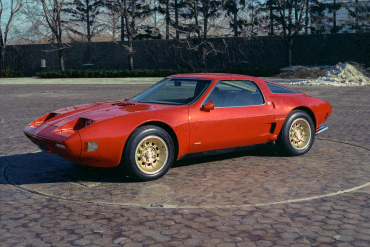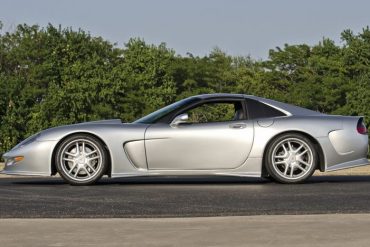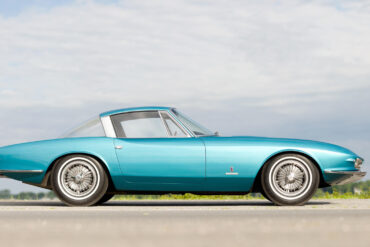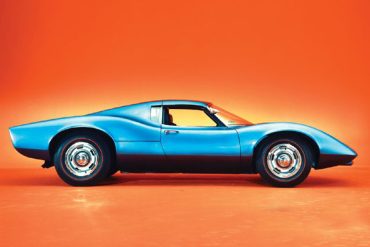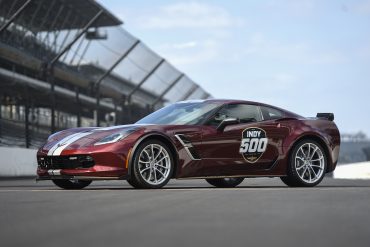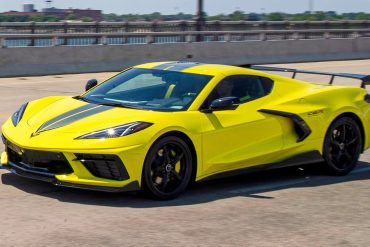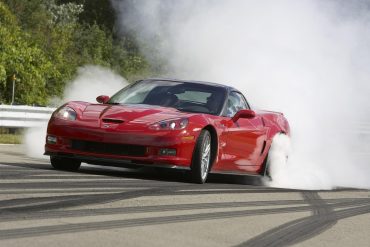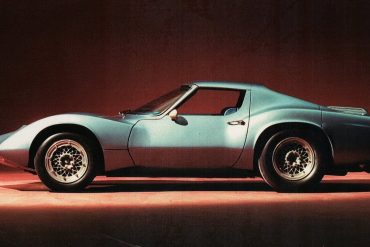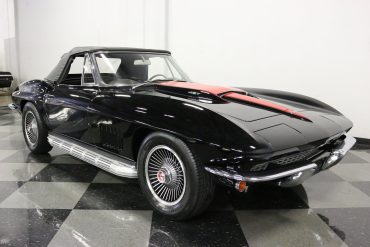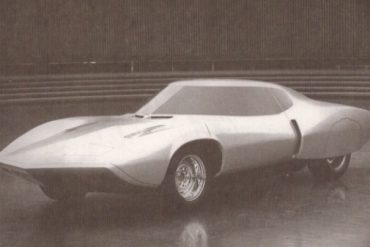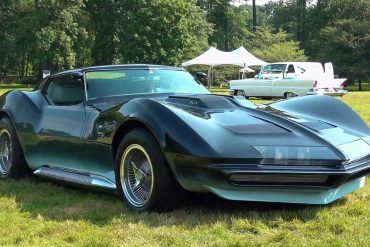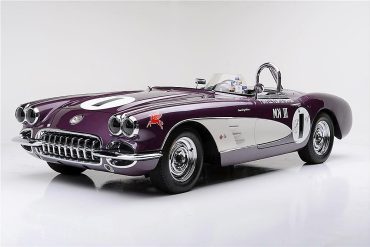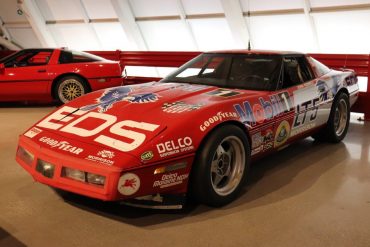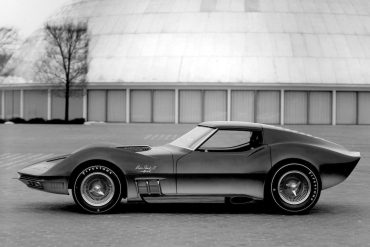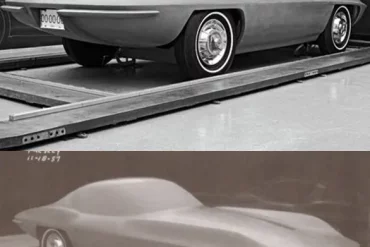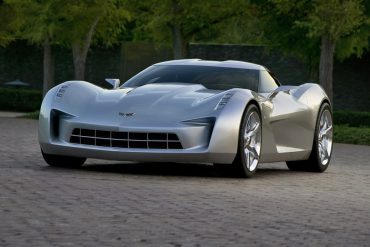The 638-hp, 6.2-liter supercharged V-8 LS9 engine features such niceties as titanium connecting rods and intake valves, a forged steel crankshaft, and a dry-sump oil system. The suspension has magnetorheological shocks that enabled Chevrolet engineers to use softer springs than in the conventionally damped Z06. Corvette's top dog model is no joke and an accomplished sports car that puts up a good fight against the world's best.
The 1963 Wedge Corvette split windshield concept was a sleek, front-engine design study that revived the Q Corvette’s split-windshield gullwing-style doors with a short, bobbed tail. Late in 1963, a GM Styling team under Henry Haga prepared this future Corvette proposal. Its sophisticated lines included side-mounted exhaust pipes.
The offspring of collaboration between Corvette performance guru Reeves Callaway and designer Paul Deutschman, the Super Speedster LM is an astonishing step up on the original Speedster, taking full advantage of the ZR1’s Lotus-engineered, all-aluminum DOHC engine and 6-speed manual transmission. One of only three twin turbocharged and intercooled LT5 engines built by Callaway, it delivers a pavement-shredding 766 HP.
The XP-819 Corvette prototype was introduced in 1964 by Frank WInchell and Larry Shinoda as the first, experimental, rear-engine Corvette coupe. The XP-819 was developed in the mid-1960's as an engineering exercise to determine if a rear-engine platform was right for the Corvette program. During that time, Chevrolet was still under a racing ban.
In 2006, the company behind the Corvette C6.R pulled out all the stops and developed a Corvette (based on a Z06 donor car and a lot of amazing engineering) that featured an unprecedented amount of horsepower and torque under its hood while packing ultimate luxury inside its ultra-wide carbon-fiber body. The car, which was revealed at the SEMA show in 2007, was called the C6RS Corvette.
At Sebring in 1967, the Corvette L88 made its debut appearance. The L88 package included many competition components which included a M22 transmission, large disc brakes, upgraded suspension and an alumunim head 427. Shortly after the race, the L88 option would be offered on production cars which was a formidable package.
The 427 Limited Edition option, code Q8A and Z44, was limited to 505 examples globally with 427 destined for North American customers. As a retirement gift to Wil Cooksey, the Corvette plant manager from 1993 to 2008, he chose the color scheme and hand signed and numbered the underside of the armrest console lids on all 505 examples in which this example is #6. As part of the package, the seats and the floor mats have “427” embroidery, and the center-console trim plate is color matched.
The Callaway C16 was Callaway’s 16th major automotive project. It was a limited production, bespoke automobile, built to order, by what the Press called “the best specialist engineers in the business”. These cars are seriously fast, beautiful, and exclusive. The C16 was a direct competitor for the Porsche GT3, the Lamborghini Murcielago, the Ferrari 599 GTB. It was both faster and more capable than its competitors, at less cost.
What you see before you is a 1982 Chevrolet Corvette that has been fitted with a rare Greenwood Daytona body kit. The most extreme of the Greenwood brothers' kits, the Daytona body kit is a highly sought-after modification that was developed by race-winning specialists Burt and John Greenwood.
The 2010 Grand Sport Corvette was introduced to the world at the 12th annual C5/C6 Corvette Birthday Bash, which was (and is) held at the National Corvette Museum in Bowling Green, Kentucky. During its unveiling, it was announced that the new Grand Sport would be offered as either a coupe or a convertible, and it would feature an appealing combination of the LS3 power plant fused with the Z06 Corvette’s wide track chassis and styling features.
The 2011 Chevrolet Corvette Z06X Track Car Concept was designed to suggest new components and a new idea for transforming a production Corvette into a serious and closed-course track car. This track car concept was developed and produced by Chevrolet in partnership with Pratt and Miller, the partners in Corvette Racing in the American LeMans Series. The competition-oriented modifications of the concept include a polycarbonate rear window, roll cage, safety harness, racing seat.
If you were a senior GM employee, one of the perks was being able to have your own custom built for you. Bill Mitchell was known for it, but this SR-2 Lookalike was built for GM president Harlow Curtis, who was president of GM during the period that the SR-2 were developed. The lookalike was built by GM’s styling staff and presented to him.
In 2003 Dick produced his version of a 50th Anniversary Corvette. Dick’s 50th Anniversary Corvette was bright gold with blue accents. And of course a “special” Corvette should be the toughest available version, which in 2003 was the Z06. And to top it all off, the Z06’s LS6 was opened up to the magical “426 CID.” The GS80 came out in 1986 that was more or less a Showroom Stock-prepared black beauty with very trendy lace wheels.
These Big Block cars would be the high-water mark of Corvette performance and refinement for the C2 series of cars. The 427/400hp L68 came standard from the factory with the Holley triple two-barrel carburetor arrangement called Tri-Power. Only 2101 Corvettes in 1967 received this rare engine option which was a $305.50 cost.
This little concept mounted a 180-horse Wankel transversely, driving a new automatic transaxle being developed for the forthcoming X-body Citation. Designed by GM's Experimental Studio and built in 6 months on a modified Porsche 914 chassis by Pininfarina, the 2-Rotor made its debut at the 1973 Frankfurt show.
Callaway has built a firm reputation for producing some of the most sophisticated and advanced Corvette-based automobiles. Introduced in 1998, Callaway’s C12 continued this proud legacy. Designed, developed and constructed by two top German engineering and development companies, Callaway and IVM, the C12 was intended as a bespoke, high-performance car that offered its occupants a civilized interior and relaxed ride. One of the most respected Corvette super-cars ever.
The Corvette Rondine concept was built by Pinanfarina and introduced at the 1963 Paris Motor Show. The car started life as a 1963 split-window Corvette, which is all the more unusual because Chevrolet introduced the split-window coupe at the same time that Pinanfarina was introducing a custom-built Corvette based on that very same platform.
The Astro II was one of the most significant case studies of Duntov’s outright refusal to let his mid-engine dreams die, and as such, ultimately entered the history books as a precursor to the eventual mid-engine, C8 Corvettes of today. The Astro II was designed in a way that was more representative of the Corvette’s typical styling cues, than that of The Astro I.
The 2019 Corvette ZR1 was the official Pace Car for the 2018 Indianapolis 500 presented by PennGrade Motor Oil and led drivers to the green flag on Sunday, May 27, for the 102nd running of the legendary race. It marks the 15th time a Corvette has served as the official Pace Car since 1978, and the 29th time a Chevrolet has led the field dating back to 1948, when a 1948 Fleetmaster Six convertible paced the race.
Immediately following this unveiling, consumers began clamoring at the opportunity to become one of the fortunate few to own their own IMSA GTLM Championship C8. Chevrolet filled all 1,000 orders for the race-inspired commemorative C8 in record time, as production commenced. Those lucky enough to place their order before the mandatory production cap was reached, were treated to a handful of IMSA GTLM Championship C8 variants to choose from.
The 638-hp, 6.2-liter supercharged V-8 LS9 engine features such niceties as titanium connecting rods and intake valves, a forged steel crankshaft, and a dry-sump oil system. The suspension has magnetorheological shocks that enabled Chevrolet engineers to use softer springs than in the conventionally damped Z06. Corvette's top dog model is no joke and an accomplished sports car that puts up a good fight against the world's best.
The XP-819, developed in the mid-1960s, was an engineering exercise to test a rear engine concept for the Corvette. The body was designed by Larry Shinoda. You can see styling cues in XP-819 that later appeared in Shinoda's famed "Sting Ray" design. A GM marine engine powers the car so the two-speed transaxle would operate properly. The entire chassis, suspension, and steering are custom made components unique to this car.
The L71 was Chevrolet’s most powerful engine in 1967 which replaced the big-block L71 from the previous year. Using it’s famous ‘Tri Power’ intake manifold was rated by the factory at 435 bhp. Costing $437.10, 3,754 Corvettes were made with the L71 options and they could not come with automatic transmissions nor air conditioning.
To clothe the 1965 mid engine Corvette chassis, the designers at Styling Staff proposed a much more radical shape than Zora Arkus Duntov, the main force behind a mid engine Corvette, had in mind. It would have provided rear vision solely through a periscope. The design had bold air intakes at the rear and a split windscreen that lifted up with the gullwing doors.
The Manta Ray was actually the 1965 Mako Shark II (XP-830) with a few upgrades, so it featured many of the Mako II's outward features, such as side exhausts and a lower-body (along the rocker panels) silver paint job. The front end had a pointed chin spoiler and the headlights used 2 banks of 3 quartz-halogen lights.
The Purple People Eater MKIII is a 1959 Corvette that was literally unbeatable in SCCA B-Production racing in the late 1950s. There were three Purple People Eaters built in 1958 and 1959. The 1959 model, won every race it entered, except the last one, with Jim Jeffords behind the wheel and mechanic Ronnie Kaplan turning wrenches. The car was built by a team at Nickey Chevrolet in Chicago.
On March 1-2 1990 a unique group of people using a Chevrolet Corvette ZR-1, reset The 24-hour World Speed Record. That achievement proved unequivocally that the car is indeed...King of the Hill. "The 24" had stood for 50 years. Last set at Bonneville in 1940 by AP Jenkins driving the "Mormon Meteor Ill", a purpose-built. single-seat race car with an aircraft engine. The objectives: set the 24 as well as 5000 kilometer and the 5000 mile marks with a ZR-1 while using an L98-powered Corvette to set the six-hour record and other shorter distance marks.
The Mako Shark II was a radical concept that shaped Stingray years later. While showcasing distinct design cues, the Mako Shark contained many notable features for 1965. It had a one-piece front-end that hinged forward for access to the engine bay, a removable hardtop, knock-off aluminum wheels and a big-block 427. Chevrolet received overwhelming requests to have it produced.
Duntov laid out three design concepts that took decades to implement. The first was his proposal for the 1957 Q-Corvette. This design called for the following: an all-aluminum, fuel-injected small-block engine, four-wheel independent suspension, four-wheel disc brakes, and a transaxle. This design concept arrived in 1997 as the C5.
SIDESWIPE takes the form of a sleek, vision concept dreamed up by the Corvette designers at GM. The design is influenced by the original Stingray race car, introduced in 1959, but also draws on Corvette heritage cues from other generations. It brings them together in a futuristic shape that seems to be equal parts racecar and space ship.


